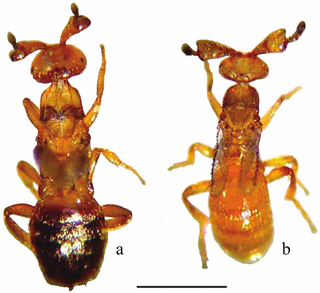Related Research Articles

Chalcid wasps are insects within the superfamily Chalcidoidea, part of the order Hymenoptera. The superfamily contains some 22,500 known species, and an estimated total diversity of more than 500,000 species, meaning the vast majority have yet to be discovered and described. The name "chalcid" is often confused with the name "chalcidid", though the latter refers strictly to one constituent family, the Chalcididae, rather than the superfamily as a whole; accordingly, most recent publications (e.g.,) use the name "chalcidoid" when referring to members of the superfamily.

The Eulophidae is a large family of hymenopteran insects, with over 4,300 described species in some 300 genera. The family includes the genus Elasmus, which used to be treated as a separate family, "Elasmidae", and is now treated as a subfamily of Eulophidae. These minute insects are challenging to study, as they deteriorate rapidly after death unless extreme care is taken, making identification of most museum specimens difficult. The larvae of very few species feed on plants, but the majority are primary parasitoids on a huge range of arthropods at all stages of development. They are exceptional in that they are one of two hymenopteran families with some species that are known to parasitize thrips. Eulophids are found throughout the world in virtually all habitats.

Afrotroppopsis is a monotypic genus of hymenopteran insects of the family Eulophidae.
Anaprostocetus is a genus of hymenopteran insects of the family Eulophidae.
Baeoentedon is a genus of hymenopteran insects of the family Eulophidae, they are parasitoids of whitefly from the family Aleyrodidae which are found on trees of the genus Ficus. They have been recorded from Australia, China, India, Indonesia and Florida. A fifth species, Baeoentodon farazi, was described from Karnataka, India, in 2017.
Chouioia is a genus of endoparasitic wasp of the family Eulophidae. Chouioia cunea is considered an important parasite of the fall webworm in China, where the moth is an invasive species.
Dicladocerus is a genus of hymenopteran insects of the family Eulophidae.
Eprhopalotus is a genus of hymenopteran insects of the family Eulophidae. Their distribution varies between species but ranges from Costa Rica, Mexico to Texas. There are currently 5 species of Eprhopalotus:

Galeopsomyia is a New World genus of hymenopteran insects of the family Eulophidae. The genus is a hyperparasitoid of other gall-inducing wasps of the genera Eurytoma and Torymus.
Goetheana is a genus of hymenopteran insects of the family Eulophidae. As a parasitoid of thrips, this wasp is used in biological pest control.

Melittobia is a genus of hymenopteran insects of the family Eulophidae.
Microdonophagus is a genus of hymenopteran insects of the family Eulophidae.
Microlycus is a genus of hymenopteran insects of the family Eulophidae.

Minotetrastichus is a genus of hymenopteran insects of the family Eulophidae. They are parasites of leaf-mining Lepidoptera, Coleoptera, and Hymenoptera.
Paracrias is a genus of hymenopteran insects of the family Eulophidae. Larvae are gregarious parasitoids of Curculionoidea, with P. huberi being a parasitoid of H. analis.

Pediobius is a genus of hymenopteran insects of the chalcid wasp family Eulophidae. Like their relatives, the larvae of these diminutive wasps are parasitoids of various arthropods. Some Pediobius are used in biological pest control.

Quadrastichus is a genus of hymenopteran insects of the family Eulophidae.
Trisecodes is a genus of parasitic chalcid wasps of the family Systasidae. The genus was originally placed in Eulophidae, based on a number of morphological features, but molecular evidence suggests that the genus is more closely related to Systasis and Semiotellus. The type species is a parasitoid of a range of Agromyzid leaf-mining flies.
Karl-Johan Hedqvist was a Swedish entomologist who focused on wasps (Hymenoptera), especially chalcid wasps and other parasitoid wasps. He described 260 species and over 70 genera of wasps.
References
- 1 2 3 4 5 6 7 8 9 10 11 12 Talebi, Ali Asghar; Khoramabadi, Abbas Mohammadi; Rakhshani, Ehsan (1 December 2011). "Checklist of eulophid wasps (Insecta: Hymenoptera: Eulophidae) of Iran". Check List. 7 (6): 708. doi: 10.15560/11008 .
- 1 2 3 4 5 6 7 8 9 10 11 12 Jamali, Majid; Zeya, Bin; Ahamad, Mukeem (2023-06-01). "AN UPDATED CHECKLIST OF ENTEDONINAE WASPS (HYMENOPTERA: CHALCIDOIDEA: EULOPHIDAE) OF INDIA". Munis Entomology and Zoology Journal. 18 (2). ISSN 1306-3022 . Retrieved 2024-05-05.
- 1 2 3 4 5 6 Gadallah, Neveen S.; Yefremova, Zoya A.; Yegorenkova, Ekaterina N.; Soliman, Ahmed M.; El-Ghiet, Usama M. Abu; Edmardash, Yusuf A.; Edmardash, Yusuf A. (15 December 2015). "A review of the family Eulophidae (Hymenoptera: Chalcidoidea) of Egypt, with thirty three new records". Zootaxa. 4058 (1): 66–80. doi:10.11646/zootaxa.4058.1.3. PMID 26701507.
- ↑ Gauthier, N.; Lasalle, J.; Quicke, D. L. J.; Godfray, H. C. J. (October 2000). "Phylogeny of Eulophidae (Hymenoptera: Chalcidoidea), with a reclassification of Eulophinae and the recognition that Elasmidae are derived eulophids". Systematic Entomology. 25 (4): 521–539. doi:10.1046/j.1365-3113.2000.00134.x.